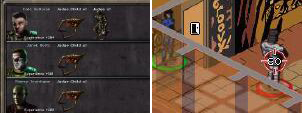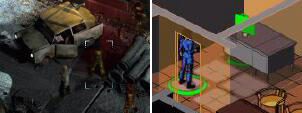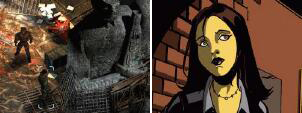A long time ago, back when Quarter to Three was just in its conceptual stage as a comprehensive Majesty cheat/hint site, a couple of turn-based strategy games called Odium and Shadow Watch appeared out of nowhere – and then disappeared just as quickly. Like Keyser Söze. I played both, and have some pretty strong ideas about these two games. Thanks to the voices in my head telling me to write this, you’re about to read them.

Shadow Watch is kind of a sacred cow at this website, sort of like Flying Heroes and very much not at all like Deus Ex. I also noticed that a lot of Usenet “denizens” chose Shadow Watch as one of their best strategy games of 2000, while all Odium managed was a few “avoid at all costs” posts. I’m here to tell you that this is backwards.
In case that didn’t quite make sense the first time, let me put it another way: Shadow Watch is a bad game. This can be proven objectively through science. Unfortunately, you can’t do science on a web page (that is, without fancy Javascript and lasers), so I’m going to have to resort to proving my hypothesis through a really smart-ass essay about computer games. If that’s not your kind of thing, I hear that Daily Radar has an article about Valentine’s Day and gaming. Maybe you’d rather read that.
To compare Odium and Shadow Watch, I’d love to ponderously enumerate how the two games stack up in terms of graphics, interface, sound, gameplay, multiplayer, and box art, much like one of those endless Adrenaline Vault reviews. Unfortunately, I’ve been informed by Adrenaline Vault’s lawyers that I can’t license their game review engine, so I’m pretty much stuck evaluating one thing: the game design. Fortunately for this article, that’s all that matters.
Those of you who are afraid this is going to degenerate into some long, pointless philosophical essay about how game design can emulate art can rest easy. Games aren’t art. I disagree with basically everything Tom Chick has ever said or will say on any topic, but I agree with him about that. While Diablo may be in the details, the basics of what gamers look for in strategy games come down to three simple criteria: a game should be about a subject that interests them, have a reasonable number of non-trivial decisions to make throughout the game, and look really, really cool. That’s it.
Oh, sure – gamers concoct all sorts of 95 Theses of Gaming to post on game developers’ doors, but the reality is that if the notoriously bad Squad Leader had had decent terrain graphics and believable unit animations and no actual gameplay changes whatsoever, it would have been a decent game instead of an abysmal one. It still wouldn’t have been a realistic wargame, but it would have satisfied a lot of people. Only a small minority of strategy gamers really wants to model the differences between an M4A1(76)W and an M4A3(76)W, and they all hang out on the Combat Mission message boards, anyway. As for topics, the Hague Convention of 1978 limited developers to a few subjects for computer game stories: aliens, Tolkien-based creatures (orcs, elves, hobbits), medieval times, military-history-based situations somehow involving Hitler or a Hitler-like character, and secret agents. Considering how most of the classic games of the past twenty years have stuck to these subjects, it obviously doesn’t take much to satisfy criterion number one.

When it comes to looking cool, both Odium and Shadow Watch have some problems. Odium’s 3D presentation looks much better on the adventure map than it does in the tactical battles. Shadow Watch has an interesting hand-drawn, comic-book style, but undermines this with an inconsistent sense of aesthetics where people who get shot flop over like Shemp Howard and your objective is neon green floating luggage. Nevertheless, both games are visually appealing enough to satisfy criterion number three. That brings us to the real game design element: presenting gamers with non-trivial decisions.
Whether a game is about fantasy monsters or the other kind, you only have to look as far as the classic X-COM for a fundamental truth about this genre: it’s not all about the tactical combat. Shooting guys with little itty-bitty guns is a blast, yes, but unless there is a sense of discovery, you’re simply replaying the same set-piece battle over and over. That gets old very fast. You can change the maps around and introduce new monsters and weapons, but for this to make any sense it has to be within the context of a story.
Odium takes a pretty conventional path through the game’s story, but one that does a good job of providing the tactical element with hooks necessary to make the game involving not just as a combat exercise, but also as a developing series of events. It doesn’t matter that the events add up to a dumb story. All computer game stories are dumb. It’s the law. The point is that the combination of anticipation and tactical decisionmaking keeps you involved even in the face of the hackneyed “secret experiments gone wrong” premise. That’s the strength of Odium: the plot progression helps make the other parts of the game engaging.
Shadow Watch’s story is simply irrelevant. As an experiment, whenever I was presented with a choice of missions, or the need to question non-player characters, I took a friend’s advice and closed my eyes while throwing my mouse in the vague direction of a large photo on my wall of former White House chief of staff Bob Haldeman. You know what? It didn’t matter. No matter what choices I randomly selected by smashing my mouse against my favorite Watergate felon’s visage, I got to go on the missions, and I never needed to find out why. Shadow Watch hadn’t learned the lesson that Baldur’s Gate should have taught to all the games it met socially: text boxes for dialogue only work in role-playing games based on the magic of elvenlore. All that reading doesn’t do anyone any good, especially if you’re just going to keep meeting the same enemies every time. Which, in Shadow Watch, you do.
Shadow Watch severely underestimates the story value in a game. This doesn’t just refer to the “why things are happening” part. It also includes the things that happen within the game. Empire-building games with tech trees create a powerful desire for new technology (“If I can just get Chariots, I can smoke him!”) that is never quite satisfied (“If I can only get Chariots and Catapults, then I can smoke him!”). When playing games with individual characters instead of massive empires, this lament becomes, “If only I had a submachine gun. Or a +1 broadsword.” Or a fucking life. Whatever. The point is, you want more stuff because it allows you to progress further in the game. Thus, when you get more stuff, you’re happy. This is really the whole point of life, which is why Richard Mellon Scaife bought Pittsburgh.
In Odium, you do indeed get more stuff. You find a flamethrower thing, and gleefully set monsters on fire, until you find that some monsters are immune to fire (role-playing alert) and have to use a different weapon against them. You learn to hoard ammo for certain guns, and switch weapons in combat so as to preserve precious long-range weaponry. And every now and then, you get weapons that help you solve some particularly difficult combat, as long as you’re smart about how you use them. The flamethrower sets things ablaze and causes damage over multiple combat rounds. There’s that gun that shoots an energy beam and can take out an entire row of guys, including your own if you’re not careful. Every time you find a new weapon or item, you can’t wait to see what it does. It’s wicked.
In Shadow Watch, you get dick for new stuff.

One of the few weaknesses Odium has is that it’s not replayable, since it’s linear and relies on your anticipation of new challenges to keep your interest. However, Shadow Watch is also not replayable, because it isn’t even playable – you can’t play it a second time because you probably won’t get through it the first time. So I guess on that point, the games are tied. Congratulations.
A turn-based tactical-level game needs to divide its battles into a reasonable number of slices of time so that each turn is interesting yet the game doesn’t move too fast or give an overwhelming advantage to the side that happens to move first. Graduates of Computer Game Story School will recognize this as “pacing.” Surprise: pacing is just as important for manly-man tactical military games as it is for all those games your girlfriend’s annoying roommate likes because they tell stories and are non-violent. If you don’t count vampires as violent, which I don’t. Anyway.
A good rule of thumb that I just made up right now is that there should be something meaningful for each character or unit to do in every turn. This doesn’t have to be actually firing a weapon. It can be dashing across a street, climbing a building, outflanking an enemy, getting out of the fucking way, or whatever. Something that makes a difference.
Shadow Watch fails this test miserably, to the point that there will be some turns when the only thing your characters will be doing is … kneeling. I mean all of your characters, not just the Catholics. In Odium, you find yourself planning a couple turns ahead, so as to trap an elusive monster in a crossfire between your maneuvering soldiers. In Shadow Watch, you’re looking forward either to five turns from now – when you just may be able to get through that door that is two squares away – or dinner. Let’s not even talk about the fact that once the mission is over, you have to move everyone back to the exit, one turn at a time.
Both Odium and Shadow Watch take place on fairly small maps. This has huge implications for tactical combat, because as many disturbed-individuals-turned-disgruntled-investors have learned, if you’re trying to kill someone, the kind of gun you’re using doesn’t really make any difference if you’re standing in his office. Thus, weapon differences (which are a major part of larger-scale tactical games like Jagged Alliance 2) become irrelevant from a realism perspective. In addition, as the scale gets smaller, the number of actions a unit can take has to decrease, or there are no decisions to make – you simply do everything. Run through the door, shoot that guy, take cover, reload, etc. No planning required. Shadow Watch tackled this problem by just chopping time up into such small segments that each turn became incredibly boring. Odium used another approach entirely.
In Odium, weapons have very stylized zones of fire. Pistols can only shoot orthogonally, while rifles have the additional capability of firing along the diagonal. The orthogonal vs. diagonal dichotomy is an incredibly elegant way of making a range distinction between two weapons without using a lot of map space. The reason for this is that due to the concept of angular velocity, you don’t have to move as far to engage someone on the diagonal as you do orthogonally. Thus, you can be much farther away to use a rifle effectively, while with the proper combination of obstacles, a pistol shouldn’t be effective from more than a couple squares away because that’s how close you have to get to be on the same row of squares as your opponent with an unblocked line of sight. Regularizing firelanes on the map grid makes it possible to highlight weapon differences (albeit in an abstract, “unrealistic” way) and turn them into a tactical consideration. Combined with the fact that some map objects (like gasoline barrels) can be detonated by gunfire, the stylized combat system requires a great deal of strategy. Of course, it also runs the risk of offending people who insist that “rifles don’t shoot diagonally.”
The funny thing is that Shadow Watch has this completely unrealistic square grid as well, but I guess this is ok if it fits well into this “all-blue comic book” art motif. Fine. Give the artists and art director credit – Shadow Watch has more style and better art direction than Odium. Unfortunately, it seems that the Art Director pretty much ran roughshod over the Director of Making the Game Possible to Play Without Becoming Exasperated, because when combined with the isometric perspective, the artwork manages to make the line of sight completely unworkable. You can never quite tell what your characters can see, or where an enemy could be hiding, or which squares are even playable. It’s hella annoying.
Because of this, Shadow Watch is a painful crawl through every level in which your agents have to move very slowly, kneel down a lot, cover each other, and essentially inch their way through each mission. Because of the horrible action-point imbalance (pacing!) mentioned earlier, each turn is only marginally interesting because very often you do nothing of note. If the weapons are all the same, and movement is divided up into such small slices that it’s all the same, then what makes Shadow Watch engaging? Comic-book art? Wouldn’t it make more sense to just read a comic book? I don’t know, I’m just asking.

Odium avoids all of these problems. You can see where the enemy is, you can see where you’re going, you can fire and move in each turn, the battles are interesting, and the puzzle-like nature of the game gives you a lot to think about with a minimum number of extraneous details. This provides everything you could reasonably expect from a game, and the story elements support the tactical combat with new items, unexpected monsters, etc. Just like I said. Brilliant.
Right about here, I’d sum up by saying that overall, Odium and Shadow Watch each have good and bad points, and that while neither one is a classic like X-COM, if you like this type of game you may or may not like Odium and/or Shadow Watch. But since that would almost certainly get me a call from Adrenaline Vault’s lawyers, I’ll reiterate my original point: Odium has game design in spades. Shadow Watch has art design. If you haven’t head a chance to play either of these games yet, I hope it’s clear which one deserves your hard-earned money. For great justice.
Discussion
No comments yet.